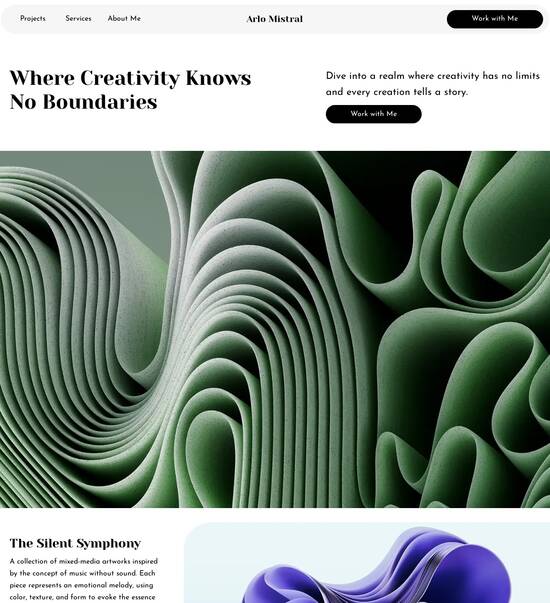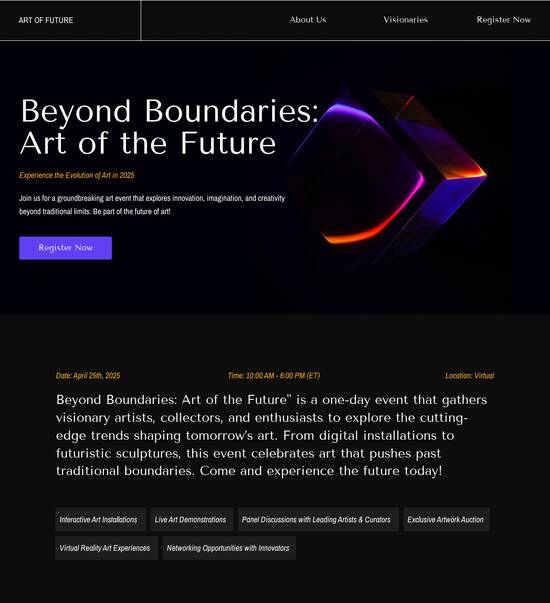
Gold API documentation page template
Explore Similar TemplatesAbout template
Discover a stylish gold API documentation page template that reflects your unique style!
Recommended templates

Easy to build without coding
With the intuitive drag-and-drop builder, anyone on your team can create high-converting pages without any knowledge of code or design. Make enhancements to your landing page with custom widgets using Javascript, HTML/CSS, or third-party scripts.

Multiple layouts for any industry and goal
Select from 500+ landing page layouts built to boost conversions across industry-specific scenarios. Customize them by adjusting fonts, adding images, and generating on-brand content with the AI assistant. Quickly scale with Instablocks® and Global Blocks that you can save, reuse, and update globally.

Loads fast and looks polished on any device
Every template is responsive, which means they present professionally on any device and load blazingly fast with our Thor Render Engine. You can also power them up with Google AMP technology to deliver an unparalleled mobile experience and drive higher conversions.

Robust analytics & experimentation
Get real-time updates and reporting across all your devices, showing the number of visitors, conversions, cost-per-visitor, and cost-per-lead. Launch AI-powered experiments, run A/B tests, and use heatmaps to analyze user behavior, then optimize your landing page to maximize conversions.







Easy to build without coding
With the intuitive drag-and-drop builder, anyone on your team can create high-converting pages without any knowledge of code or design. Make enhancements to your landing page with custom widgets using Javascript, HTML/CSS, or third-party scripts.
Multiple layouts for any industry and goal
Select from 500+ landing page layouts built to boost conversions across industry-specific scenarios. Customize them by adjusting fonts, adding images, and generating on-brand content with the AI assistant. Quickly scale with Instablocks® and Global Blocks that you can save, reuse, and update globally.
Loads fast and looks polished on any device
Every template is responsive, which means they present professionally on any device and load blazingly fast with our Thor Render Engine.
Robust analytics & experimentation
Get real-time updates and reporting across all your devices, showing the number of visitors, conversions, cost-per-visitor, and cost-per-lead. Launch AI-powered experiments, run A/B tests, and use heatmaps to analyze user behavior, then optimize your landing page to maximize conversions.
All the features you need to build instapage api
Explore more featuresLearn how to build top-performing landing pages for any goal
FAQs
Leading the way in building high-performing landing pages





A step-by-step guide to mastering Instapage for optimizing landing pages
Unlock the full potential of your digital marketing campaigns with Instapage, the leading landing page and Conversion Rate Optimization (CRO) platform tailored for diverse verticals like Business Services, Tech, and Education. In this guide, we’ll walk you through the essential steps to create, optimize, and personalize landing pages that maximize your ROI.
Step 1: Accessing templates and lead generation elements
Getting started with Instapage is seamless, thanks to its extensive library of over 100 high-converting templates. Choose a layout that fits your campaign objectives and customize it using pre-built lead generation elements. This flexibility allows marketers to create impactful landing pages without the need for coding expertise.
- Select from various templates catered to different industries, ensuring relevance to your target audience.
- Utilize lead generation elements like forms and pop-ups that seamlessly integrate with marketing tools.
- Preview your landing page in real-time to make adjustments efficiently before launching.
Step 2: Building and optimizing your landing pages
Once you have your template, Instapage’s intuitive page builder lets you adjust layouts and content quickly. Focus on crafting engaging headlines, images, and call-to-action buttons that resonate with your visitors.
- Incorporate A/B testing to compare variations and identify which elements drive better conversions.
- Use heatmaps to analyze user behavior on your page, allowing for data-driven decisions in design.
- Regularly revisit and adjust your content based on performance analytics to sustain high engagement.
Step 3: Personalizing and collaborating to improve performance
With Instapage’s advanced personalization tools, deliver tailored experiences to your audience. Dynamic text replacement can help align your ad messaging with landing page content, enhancing user experience and conversion chances.
- Utilize AdMaps for targeted audience-specific pages that enhance engagement.
- Collaborate with team members or stakeholders for real-time feedback to speed up page production.
- Share your work securely to get insights from external partners while retaining control of your content.
Optimizing your landing pages is an ongoing process. Regularly analyze performance metrics and adapt your strategies based on user feedback.
In conclusion, leveraging the features of Instapage can significantly enhance your online marketing efforts. By following this step-by-step guide, you can create powerful landing pages that meet your campaign goals.
Ready to take your marketing campaigns to the next level? Start using Instapage today and experience the transformation in your landing page performance!
People also ask about Gold API documentation page template
Elevating User Engagement: The Anatomy of a Gold API Documentation Page Template
Purpose and importance of API documentation
API documentation serves as the bridge between the code and its users, offering a clear pathway for developers to understand, integrate, and utilize an API effectively. In modern application development, this documentation plays an essential role, providing definitions, endpoints, and workflows that clarify how to interact with the service. A well-structured API document isn't just a manual; it's a crucial communication tool that unifies teams across disciplines, ensuring developers, product managers, and customer support representatives are all on the same page.
The impact of comprehensive documentation extends well beyond clarity. For developers, it represents a resource that mitigates confusion and minimizes error-prone implementations. Any ambiguity in documentation can result in higher support calls and integration failures. Therefore, accurate, updated documentation not only boosts team efficiency but also enhances user confidence in the API, fostering a seamless development experience that leads to successful applications.
Key components of a gold API documentation template
An effective API documentation page template should clearly define its core elements. This includes providing detailed descriptions of endpoints, input parameters, request methods (GET, POST, PUT, DELETE), and the structure of responses. Developers benefit dramatically from having real-world examples—the more relatable and contextually relevant these examples are, the easier it becomes for users to adapt the code to fit their projects. Incorporating use cases showcases practical applications and enhances comprehension.
A focus on user-friendly layout and navigation further ensures that developers can locate what they need swiftly. Organizing documentation in a hierarchical structure with clear categories and manageable navigation aids reduces user friction. Adding search functionality empowers users to find specific information without sifting through pages of content. Good organization helps maintain a logical flow, ensuring users can access related information seamlessly.
Technologies behind a robust documentation framework
Creating effective API documentation often involves leveraging popular tools and platforms. Documentation generators such as Swagger and Postman provide intuitive interfaces that facilitate the creation and maintenance of clear API documentation. These tools offer dynamic documentation approaches that automatically update as APIs evolve. While static documentation can sometimes present challenges in keeping up-to-date, dynamic solutions can ensure users access the latest details without manual intervention.
Integrating API documentation with development workflows is paramount for ongoing accuracy. By syncing documentation with code repositories through tools like Git, teams ensure that updates to the API are reflected in real-time. This continuous integration approach not only keeps documentation relevant but also strengthens collaboration among developers, enabling them to focus on building rather than documenting, thus creating a more cohesive development environment.
Crafting engaging content for developers
The style of writing within API documentation can significantly impact the user's experience. Adopting a conversational tone makes technical content more approachable, diminishing the intimidation factor often associated with complex documentation. It's vital to break down intricate concepts into shorter segments that are easier for users to digest. Use of headers and bullet points helps create a visually accessible layout, enhancing readability and user satisfaction.
Additionally, incorporating interactive elements like code snippets, live demos, and interactive APIs can enrich the learning experience. Hands-on examples allow developers to experiment and learn in an applied context. Complementing textual information with visuals such as flowcharts, diagrams, and infographics not only clarifies processes but also caters to diverse learning styles, empowering users with multiple ways to engage with the material.
Community building through API documentation
An API documentation page can serve as a knowledge hub not just for developers, but for the entire community. Fostering engagement around the documentation encourages users to become active participants. Utilizing forums and Q&A sections allows developers to share insights, troubleshoot issues cooperatively, and learn from one another’s experiences, transforming documentation from a single-source reference into a collaborative platform. This communal effort enhances the overall quality and richness of the knowledge base.
Marketing the documentation effectively is also crucial in reaching targeted audiences. Engaging with the tech community via social media and platforms like Reddit or Stack Overflow can significantly amplify the visibility of your API. Gathering feedback from users and iterating on documentation can refine the quality and capture their experience accurately, ensuring it evolves in line with user needs and expectations.
Addressing common questions and challenges
An FAQ section is an invaluable addition to any API documentation page. Curating a comprehensive list of common queries enables developers to solve problems independently. Providing clear, concise answers is crucial as it directly lowers the learning curve associated with using the API. This section can also alleviate unnecessary support requests, freeing up teams to focus on more complex issues that require direct interaction.
Technical issues are inevitable, but navigating them effectively is essential to good user experience. Identifying frequent pain points and outlining troubleshooting steps can guide users through common challenges without excessive friction. Including specific project examples that demonstrate how to resolve distinct issues helps to solidify understanding and equips users with relevant strategies they can apply in their scenarios.
Leveraging team collaboration for documentation success
Developing a collaborative documentation process can dramatically improve the quality of API documentation. Utilizing tools such as Google Docs or Confluence facilitates real-time contributions from multiple team members, allowing for a diverse array of insights to enhance the content quality. Clear roles and responsibilities streamline this process, ensuring that timelines are met while maintaining accurate information flow from developers to documentation writers.
Incorporating feedback loops is a vital strategy for continuous improvement. Gathering feedback from users and internal teams on the usefulness and clarity of documentation can illuminate areas needing refinement. An iterative approach encourages frequent updates based on collective input, further enhancing the effectiveness and applicability of the documentation over time.
Redefining location and accessibility in documentation
Ensuring accessibility for all users should be a fundamental goal in creating API documentation. Following best practices involves using clear language, straightforward navigation, and alternative formats such as PDFs for users with disabilities. Prioritizing accessibility not only complies with regulations but also broadens the user base, making it easier for everyone to interact with the API.
Moreover, optimizing for multilingual support widens the API’s reach beyond local borders. Techniques such as collaboration with professional translators or utilizing community contributions can aid in delivering documentation in diverse languages. This strategy ensures that language barriers are minimized and fosters inclusivity, allowing a global audience to utilize your API effectively.
The future of API documentation: trends and innovations
The landscape of API documentation is continually evolving, with emerging technologies playing a pivotal role. AI-driven tools are beginning to enter the scene, enabling the automatic generation of documentation and offering tailored content suggestions based on user interaction patterns. This trend signifies a shift towards more personalized learning experiences, enhancing usability and comprehension for developers.
As server-side technologies advance, they are expected to influence documentation practices significantly. The future may hold more interactive and user-focused documentation platforms that integrate seamlessly with development environments, creating a unified experience for building and documentation. Embracing these innovations can lead to a documentation landscape that not only informs but actively engages users in a collaborative effort to expand knowledge.
Case studies: successful API documentation examples
Examining high-quality API documentation can provide valuable insights into best practices. Companies like Stripe and Twilio are renowned for their exceptional documentation, which seamlessly integrates usability with clarity. These examples stand out due to organized layouts, extensive use of real-world examples, and comprehensive FAQs that empower users to navigate and utilize their APIs with ease.
Key takeaways from successful projects underscore the importance of simplicity, clarity, and community engagement. Companies that continually iterate on user feedback and adapt their documentation to meet developer needs often witness higher user satisfaction and reduced support requests. Learning from these collective insights is invaluable for any organization aiming to improve its API documentation practices.
Collectives' role in documenting API ecosystems
Building a community of practice around documentation enhances quality and encourages best practices. Collectives can provide a platform for developers to share challenges and solutions, which is crucial in the fast-evolving tech landscape. Successful examples of collective efforts showcase how peer-to-peer support leads to improved API standards that benefit a broader audience.
These collectives also facilitate knowledge exchange by providing resources and mentorship opportunities, allowing less experienced developers to learn from seasoned professionals. The resulting collaboration fosters an environment where documenting APIs effectively is a shared effort, leading to enriched documentation that benefits the tech community as a whole.
Ready to skyrocket conversions?
Supercharge your ad campaigns with high-performing landing pages
Get started














